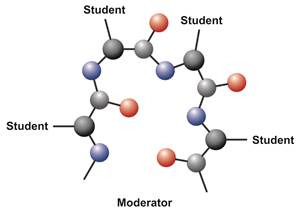|
Dr. J. Ricky Cox
| ||
|
|
||
|
Even in the undergraduate years,
students need to learn effective methods of science communication,
which include giving oral presentations (design, structure, and
delivery), answering questions, pitching ideas, and interacting with a
broad audience (specialists and nonspecialists). Below are
descriptions of some activities developed in CHE 540 (Fundamentals of
Biochemistry II) to help biochemistry students develop communication
skills that will be important in graduate/professional school and/or
the workplace. | ||
|
RESOURCES: Students were given access to a variety of
resources to help them learn and practice effective communication
skills. These include books, resources based on books, blogs and web
pages. Here are some examples: 1. Resonate (Nancy Duarte) 2. Made to Stick (Dan and Chip Heath) 3. Presentation Zen (Garr Reynolds) 4. Syd Field Paradigm | ||
|
EXERCISE: Around the
beta-Turn This activity was inspired by ESPN's "Around the Horn," where a moderator asks questions to various sports reporters and scores their answers to adding or subtracting points. In the "Around the beta-Turn" activity, students are also asked rapid-fire questions, but the questions are based on an assigned paper. Responses are scored using a grid with answers that are correct, concise, and appropriately-detailed receiving the most points and answers that are vague or incorrect receiving no points or a loss of points. Students need opportunities to practice and learn how to answer tough questions on the spot with clarity and detail appropriate for the situation and time constraints.  Description and student reaction published in the Journal of Chemical Education: HERE *Please contact me for a copy of the paper or scoring rubric. | ||
|
EXERCISE: Five-Minute Drill This activity was designed to give students skills and practice in communicating the results and scope of an important research paper in just five minutes (face-to-face, with no presentation software). And, by the way, students had to discuss this paper with a biochemist (instructor) and a nonbiochemist in seperate meetings. Since it was two five-minute presentations, with completely different audiences, there were special considerations in terms of structure, design, and stickiness (see resources above). Science students must learn to communicate with broad audiences and navigate various constraints such as time and scope. Description and student reaction published in Biochemistry and Molecular Biology Education: HERE *Please contact me for a copy of the paper or scoring rubric. | ||
|
EXERCISE: Drug Company Pitch In this activity, groups of two students assumed the role of chief science officers for a major pharmaceutical company. Each group picks a drug recently approved by the FDA (for example, recent article (by Lisa Jarvis) in Chemical and Engineering News). The goal of the presentation (10-15 min) is to persuade the rest of the class (company board) and the CEO (played by local businessperson) to continue to fund research and development on the drug. In this exercise, students learn how to design and structure an effective PowerPoint presentation (or Prezi), make a persuasive argument and pitch, and to end with a "call to action." In the end, the board and CEO vote on which team gets funding (bonus points on scoring rubric).  Thanks to local Edward Jones rep (Andrew Norman) for playing the role of CEO. Description and student reaction published in Biochemistry and Molecular Biology Education: HERE *Please contact me for a copy of the paper or scoring rubric. | ||
|
|
||
|
|
||
|
Department of
Chemistry | ||
This site was
created by Ricky Cox in the Department
of Chemistry
